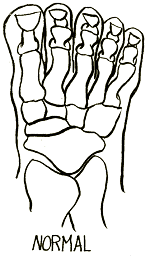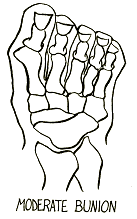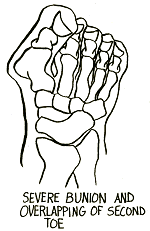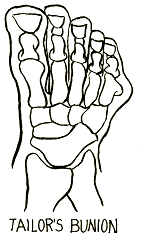|

 Mild bunions are abnormal "bumps
of bone" Mild bunions are abnormal "bumps
of bone"  formed on
the side of the formed on
the side of the  big toe
joint or on big toe
joint or on the top of the big toe the top of the big toe joint. joint.
 

 If untreated, a bunion
can ultimately If untreated, a bunion
can ultimately  lead to a more
serious arthritic lead to a more
serious arthritic  condition
of the joint or to a serious condition
of the joint or to a serious  dislocation
of the great toe dislocation
of the great toe  causing
overlapping or underlapping causing
overlapping or underlapping  of
the big toe onto the 2nd of
the big toe onto the 2nd  toe.
This problem has the medical name of toe.
This problem has the medical name of  Hallux
Abduto Valgus. Hallux
Abduto Valgus.  Even a mild
bunion can make you walk Even a mild
bunion can make you walk  improperly,
which in turn improperly,
which in turn  can lead to
pains of your arch, leg and can lead to
pains of your arch, leg and  or
back. or
back.

 After treating patients for over a third of a century I feel the number one reason for
a After treating patients for over a third of a century I feel the number one reason for
a  person to have bunions
is due to a Morton's Toe caused by Inheritance. person to have bunions
is due to a Morton's Toe caused by Inheritance.  We inherit
our feet from our We inherit
our feet from our  parents
the same way we inherit many parents
the same way we inherit many  other
traits. If mom or dad had a foot other
traits. If mom or dad had a foot  that
was prone to forming that
was prone to forming  bunions,
you will have the tendency bunions,
you will have the tendency  to
acquire the same type of to
acquire the same type of  foot.
It is not usual to see three foot.
It is not usual to see three  generations
of a family with the generations
of a family with the  same
type of bunion problems. same
type of bunion problems.  To
a much lesser extent poor To
a much lesser extent poor  posture
and ill-fitting shoes posture
and ill-fitting shoes  may
also be responsible for the may
also be responsible for the  formation
of a bunion. formation
of a bunion.
 Another type of bunion which Another type of bunion which
 some patients experience
is what is some patients experience
is what is  known as a TAILOR'S
BUNION known as a TAILOR'S
BUNION  or Bunionette. It
is located on the or Bunionette. It
is located on the  opposite
side of the foot where opposite
side of the foot where  bunions
normally appear, around bunions
normally appear, around  the
little toe joint, and emerges the
little toe joint, and emerges  as
something of a smaller bump, as
something of a smaller bump,  then
the regular bunion. then
the regular bunion.

 In its early stages, the In its early stages, the
 measures for relieving bunion measures for relieving bunion
 pain at home are relatively pain at home are relatively
 uncomplicated. Warm water uncomplicated. Warm water
 foot soaks may bring considerable, foot soaks may bring considerable,
 although transitory relief,
as does although transitory relief,
as does  cutting shoes out
over the bunion. cutting shoes out
over the bunion.
 If conservative measures
do not If conservative measures
do not  relieve the pain
and deformity, relieve the pain
and deformity,  it may be
time to refer your bunion it may be
time to refer your bunion  problem
to your podiatrist. problem
to your podiatrist.
 Please do not assume foot Please do not assume foot
 surgery is automatically
needed to surgery is automatically
needed to  treat bunion problems.
In fact foot treat bunion problems.
In fact foot  surgery for
bunions should surgery for
bunions should  always be
a last resort. There always be
a last resort. There  are
many ways to treat them are
many ways to treat them  without
surgery. without
surgery.
 Such treatments as Such treatments as
 Physical Therapy, Physical Therapy,
 Orthotics, padding
and Orthotics, padding
and  strapping (to treat the Morton's Toe), and medications strapping (to treat the Morton's Toe), and medications
 have proven
to be some of have proven
to be some of  the highly
successful non-surgical the highly
successful non-surgical  treatments
used in the treatments
used in the  Ambulatory Foot Clinic to treat Ambulatory Foot Clinic to treat
 bunions. bunions.
 Back Back
|



